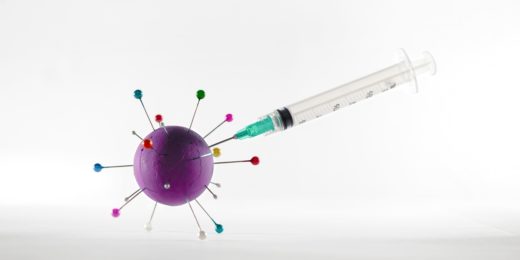At this point in the pandemic, many of us are exhausted. Exhausted by two years of intermittent lockdowns, social distancing, remote learning and masking. Exhausted by the endless "if this, then that" mental gymnastics required of a simple trip to the grocery store or gathering with a group of friends.
The tantalizing possibility that the virus that causes COVID-19 could evolve to become endemic is the floating door from the Titanic on which we'd all like to ride back to normalcy. We're anxious to say goodbye to the iceberg that so utterly destroyed our pre-pandemic lives. We talk about "learning to live" with the virus, but what we really want is for it to fade seamlessly into the background of everyday life.
But what does endemic really mean, and will we actually get there? Will there ever be a day when we can ditch our masks for good and relegate COVID-19 caseload dashboards to our distant memories? Will we ever be able to get over the feelings of loss and -- let's face it -- anger caused by the past two years of disruption? Who needs vaccine boosters and how often?
I conferred with experts from around Stanford Medicine to discuss these and other questions.
Endemic, schmendemic
Endemic is a multifaceted word. The Greek word demos means people, and endemios means native. The Merriam-Webster dictionary defines endemic as "belonging or native to a particular people or country" or something that is "restricted or particular to a locality or region." By that measure, pretty much anything can be defined as endemic: mullets sported by '80s American rock bands, heirloom Jell-O mold recipes passed down through generations of Midwestern church ladies, or fuzzy toques sported outdoors during Canadian winters.
But endemic means something more specific to biologists and clinicians. "When biologists talk about something being endemic, they are referring to a particular kind of relationship between different life forms," said David Relman, MD, the Thomas C. and Joan M. Merigan Professor, professor of microbiology and immunology, and a former president of the Infectious Diseases Society of America.
Many times, one of those life forms is a virus or bacteria that uses humans as its host. Like a lightning-sparked forest fire, the initial meeting between a pathogen and humans can be explosive. The disease-causing organism can race unchecked through a population while the human immune system struggles to catch up. Presto, an epidemic! But this kind of ongoing conflagration is not sustainable: The virus runs out of hosts to infect because they've all either become immune or died.
"In many cases, epidemic viruses fizzle out after a year or two if they are unsuccessful in establishing an endemic relationship with their host," Relman said. "Viruses want an opportunity to replicate and persist."
Clinically, an endemic relationship with SARS-CoV-2 is still tantalizingly beyond our grasp.
"If we are able to move beyond repeated, continuous surges into a time when COVID-19 is more seasonal, like the flu, it could be appropriate to call the virus endemic, meaning we can expect a certain amount of disease in a certain time or place in some predictable pattern," said Abraar Karan, MD, an infectious disease fellow at Stanford Medicine who has cared for many COVID-19 patients during the pandemic. "But I don't know when, in the next few years, this might happen. Right now, we have too many waves and variants coming back to back."
"It's difficult to know with confidence what endemicity might look like in the clinic," Relman agreed. "We may see seasonal epidemics, periodic asynchronous flares, or epidemics; or ongoing smoldering disease across the globe. But we are not there yet."
But what does endemic mean to the general public? To many, the term implies that we can relax our vigilance -- that COVID-19 is not a big deal anymore. After all, it's probably always going to be with us.
"The idea of a world with zero COVID-19 is really not possible anymore," Karan said. "The best we can hope for is to keep cases low and to prevent waves and surges."
Relman is cautiously hopeful that we are moving in the right direction. "I can't think of too many endemic microbes or viruses that, over time, have continued to cause the level of disruption that this virus has caused over the past two years," he said.
To mask or not to mask? That is ... one of ... the questions
At this point, it seems that we're straddling a line between a pandemic and an endemic virus that will be with us forever: a kind of "pendemic," if you will. Recently the Centers for Disease Control and Prevention loosened isolation recommendations for infected people and relaxed many restrictions on indoor gatherings. This move means that decisions about precautionary measures, such as masking and avoiding crowds, are up to the individual. But relaxed restrictions are not the same as telling people, "You don't need a mask."
"Evidence suggests that now is an appropriate time to loosen mask mandates based on an individual's risk profile," said Ashley Styczynski, MD, MPH, an adjunct clinical assistant professor in infectious disease at Stanford who co-authored a large-scale study on the effect of masking on community transmission in Bangladesh. "But it's still too early to say there's no use for masks at all. Of all the things we can do to slow the spread of the virus, from masking to social distancing to stay-at-home orders, masks are the least restrictive intervention. I believe they will remain a critical part of our response as the virus continues to evolve."
N95s and KN95s are similar in terms of filtration efficiency, Styczynski said. (Surgical masks are slightly less efficient.) N95 masks, which usually have straps that fit over the back of the head rather than around the ears, have the tightest fit, giving them a protective advantage. But that also means they can be less comfortable than other types of masks. The elastic on N95s, KN95 and surgical masks can weaken after prolonged or repeated use, compromising the fit. Surgical masks have the loosest fit, but they have been shown to be more effective than cloth masks at preventing community transmission.
"A person who wants to limit transmission to themselves or others should choose a high-quality mask like an N95 or a KN95," Styczynski said. "For others, a surgical mask alone or under a cloth mask could be a good choice. The most effective mask, however, is the one that you will wear. So it's important to balance mask effectiveness and comfort."
Fit is important, but a mask that leaks a bit is more effective than no mask at all, Styczynski said. "You probably won't be wearing any of these masks perfectly. But a bit of air leakage doesn't mean the mask is pointless because not all viral particles are aerosolized. Surgical masks block droplets, for example. And all masks remind people not to touch their noses and mouths frequently."
To check the fit of your N95 or KN95 mask, Styczynski recommends taking a slow breath in while wearing your mask to check for leakage. "If the material of the mask slightly collapses when you inhale, you know your mask is filtering the air," she said. "When you breathe out, cup your hands around the outside of your mask to check for air leaks."
Us and them: Collective mental health toll
One of the most obvious, and difficult to manage, tolls of the past two years is the effect of the pandemic on our collective mental health. Many of us are experiencing a stew of emotions that can bounce from anxiety to frustration to sadness -- to flat-out anger at people with whom we disagree.
"Realizing that you can't control what other people are doing and that their actions could affect your life is basically a recipe for anxiety, and that can lead to friction and stress," said clinical psychiatrist Debra Kaysen, PhD, who specializes in the treatment of post-traumatic stress disorder and related conditions.
"We're in a period now where people have to figure out where their own personal comfort zones are, and act accordingly," said Kaysen. "And this can change day by day, according to the people and activities with which they engage."
This is tough for those of us (myself included) who just want to know what to do.
Kaysen recommends breaking down a situation (say, a crowded indoor wedding) into smaller questions: Will the attendees be vaccinated? Can I wear a mask? Then seek out reliable, science-based information about specific risks. If the process is too overwhelming, she suggests setting aside a specific amount of time to worry about things and then accepting the uncertainties and moving on. "Constant worry is never helpful, and it just makes you tired," she said.
Anger is also exhausting, and rarely productive, Kaysen said. "One of the most helpful things is to try to understand the other person's perspective, at least a little," she said. "The other is to avoid dehumanizing the other person, which we often do when we assign people to groups or categories. Empathy and compassion are important."
Kaysen gives an example: "I can understand that the lockdown was an economic hardship for business owners, and that must have been especially frustrating if case levels in their area were relatively low at the time. Or I can acknowledge that wearing masks and social distancing isn't fun, even though it may be necessary at times."
It can be difficult to feel your life is restricted while others appear to be living life as normal with seemingly no consequences.
"It's become necessary to practice an acceptance of uncertainty," Kaysen said. In general, humans are pretty bad at this. "It's particularly difficult for people prone to anxiety to accept that they cannot control outcomes, particularly around what they perceive as a threat. We want things to be black and white. Instead, we have many shades of gray that make up a constantly evolving picture."
How many jabs?: Vaccine dosing a challenge
There's more clarity around COVID-19 vaccines: It's been conclusively shown that vaccination saves lives.
"It's almost miraculous how well these vaccines work," said Yvonne Maldonado, MD, the Taube Professor in Global Health and Infectious Diseases. But the initial push to vaccinate all eligible Americans stumbled in the face of vaccine misinformation and hesitancy. And subsequent recommendations about booster shots have been fraught with confusion and frustration as the public tries to parse complicated scientific information almost in real time.
"The virus is mutating quickly, and this is a challenge to vaccine manufacturers," Michael Lin, MD, PhD, an associate professor of neurobiology and of bioengineering said. "We need to develop vaccines that remain effective in the face of new viral strains for longer than six months. We're not currently in that situation."
Lin's lab researches antiviral drugs to combat SARS-CoV-2 and he has been an active proponent on Twitter, and in the media, of the need to develop variant-specific boosters against the virus.
Recently, the Food and Drug Administration authorized -- and the CDC subsequently recommended -- a second booster shot to certain groups of people who received their first booster at least 4 to 6 months earlier. But many eligible people eager for another booster are left wondering whether to get one now, even though cases are relatively low, or to wait until promised omicron-specific boosters become available.
"It really depends on what happens with the evolution of the virus and the development of new vaccines," Lin said. "But it's quite possible we could get an additional level of protection from an annual booster every fall."
Still, the available vaccines and boosters, all of which target the original strain of the virus, drastically reduce the chance of becoming seriously ill or dying. And vaccine researchers and manufacturers are continuing to optimize their shots.
"We're going to get much better at building modular vaccines that can protect against more than one variant," Maldonado said. "We're also looking at traditional platforms used by vaccines like Novavax, which could be quickly adaptable to changing conditions. We couldn't do this initially because we were focused on learning whether the first vaccines were safe -- and they are incredibly safe. Now we're going to keep improving the technology to combat future variants and even other viruses."
Down the line, COVID-19 vaccine boosters could come in the form of a sniff, rather than a jab. Nasal-based vaccines target the "front door" of viral entry, revving up immune cells in the mucosa to barricade the door the moment the virus enters the nasal passages. "This could be the best way to quash infection and prevent transmission," Lin said.
Now what?: A 'new normal' defined by uncertainty
Two years ago, we consoled ourselves with the idea that eventually we'd get back to a "new normal" in which we could comfortably cohabitate with the SARS-CoV-2 virus. Now, as the "pendemic" enters full-blown toddlerhood, we're realizing that uncertainty is a mainstay as we forge our own paths, lugging invisible abacuses bedecked with our individual risk and benefit beads and remembering what we left behind.
"There are still questions that no one can really answer with any degree of certainty," said Bali Pulendran, PhD, the Violetta L. Horton professor of pathology and microbiology and immunology. "But when historians look back at this time, there won't be any doubt about the devastating impact of this pandemic. We've seen 1 million deaths in this country. All of us have been through a war of sorts, a world war against this virus."
Read more the two-year mark of the beginning of the pandemic: Two years into the pandemic, medical scientists consider what the future may hold
Photo by Dzmitry






